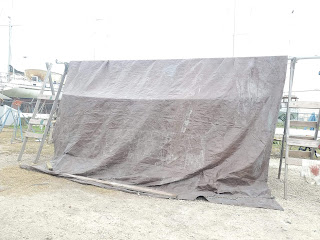Poop deck repair and stern locker rebuild on a Cape Dory Typhoon sailboat - part 1

The boat came to me with extensive core rot on the deck, cabin top, cockpit seats and cockpit bulkhead and especially on the poop deck at the stern of the boat. Here, there were multiple penetrations for deckplates, the traveler, cleats etc which had not been sealed properly letting in a lot of moisture. In addition, the camber on the deck top had been flattened down by the traveler, so it collected standing water with inadequate drainage which only added to the deck rot. Basically all the core was gone, and both remaining fiberglass layers had to be cut so I cou l d easily access the area below the poop deck to build a stern locker to store a portable gas tank. Honestly I am not a fan of two design points on these Cape Dory yachts: 1- the inaccessible bilge and 2- this very large space under the poop deck which is only accessible by a vertical deck plate with a 4" hole fitted behind and over the rudder post, just enough space to fit a hand but not much else. Since the original T...





